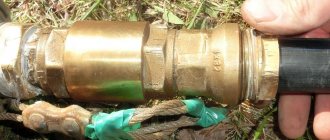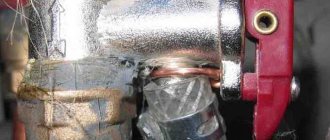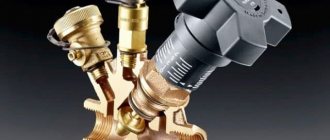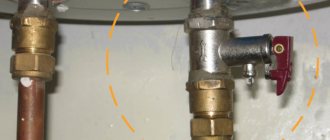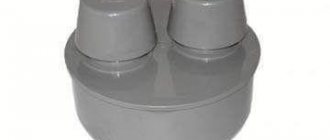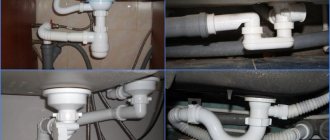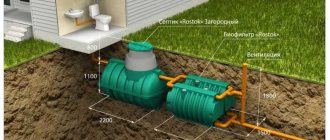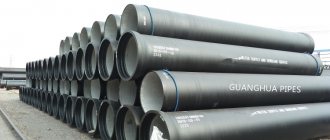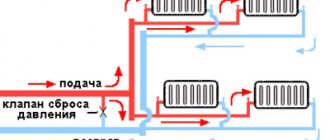A sewer check valve performs the function of a lock, which allows liquid to pass through the pipe in only one direction. What types of this device exist, when is a 110 mm or 50 mm sewer check valve used and how to install it?
The check valve used for sewerage must meet the following requirements:
- open and close with little pressure, since in most cases domestic sewer systems are gravity-flowing,
- be easily accessible for maintenance and cleaning.
Valves (they may also be sold under the name “sewer valve”) can be designed for external or internal installation. The first ones are orange, the second ones are gray.
Varieties
According to the design, the valves can be
- rotary (petal),
- lifting,
- ball,
- Wafer.
Rotary, or petal, valves have a diaphragm that rotates and opens the lumen when fluid moves in the desired direction. If the flow goes in the other direction, the membrane lowers and seals the pipe. Sometimes such devices have an additional manual shutter - another membrane that is lowered if necessary. The device also has a cover that is needed to access the inside of the device. The valve is a potential point of clogging, so it is important that it can be easily opened to solve the problem.
In lifting versions, the locking element is made on a spring; if the liquid moves correctly, it rises up, and if it moves incorrectly, the liquid begins to put pressure on the spring, thereby lowering the shutter and blocking the pipe. The structure of such a device is shown in the figure. This type is considered more reliable. For maintenance, remove the cover, which is held on by 4 bolts.
Ball sewer valves are so called because the locking element is a ball. The valve device is shown in the figure. With the correct movement of the drains, the ball rolls into a special recess, and the lumen of the pipe opens. When the fluid moves in the opposite direction, the ball blocks the lumen. The disadvantage of this design is possible leakage, since the ball is not always hermetically sealed with the inside of the housing.
Wafer valves are used on water pipes. They are smaller in size and have less clearance, so they are not placed in the sewer: they clog easily. These models are equipped with a rotary valve.
It is not recommended to make a non-return valve for sewerage yourself, since any mistake made during the manufacture and installation of the device will negatively affect the operation of the sewerage system and can lead to blockage or drainage into the house or apartment.
Most devices have a handle to forcefully close the damper. There are also electrically controlled valves; as a rule, they are installed in the general sewer system of an apartment building.
Air valve
The air valve is installed in the drain pipe. It is needed in order to let air into the sewer system and not let it out back, thus preventing the appearance of an unpleasant sewer smell in the apartment. How does a non-return air valve for sewer work?
The principle of its operation is as follows. When water is discharged into the sewer system, a vacuum occurs in the system; air must enter it from outside. If there is ventilation in the system, there will be no problems, but if there is none, then air will come from the device. Which has the smallest water seal. At this point, air with all the odors of the sewer can enter the room. An air seal helps prevent this: its membrane opens when a vacuum occurs, and closes when the pressure equalizes. Thus, the air only goes from outside into the sewer, and does not enter the apartment from the sewer.
Characteristics
Typically valves are made of plastic (PVC or polypropylene) or cast iron. Which one to choose depends on the pipe material. It is recommended to install plastic models on plastic models, and cast iron models on cast iron ones. If you use a device made of a material other than pipes, you will need to install additional adapters.
The diameter of the valves can be 110 or 50 mm. The first ones are installed on wide 110 mm sewer pipes, and the second ones - on narrow pipes after the sink and bathtub. Devices with a diameter of 110 mm are made of metal, and a check valve for sewage 50 mm is made of plastic.
Check valves are designed for a pressure of 0-3 m water column and for hydraulic tests with the same pressure.
What are they made of and what sizes do they come in?
The most common sewer check valves are made of plastic (PVC) and cast iron. If your sewer pipes are plastic, it makes sense to install the same valve, choosing it according to size. The situation is exactly the same with cast iron. The point is not that the materials are not suitable, but the need for additional adapters, which make the design even more cumbersome.
According to the installation method, the shut-off valve for the sewer can be horizontal or vertical. Select the type depending on the installation location. It must be installed with the same diameter as the pipe; narrowing is not allowed. Accordingly, there are valves for each size. The parameters of some are shown in the table.
Valve installation - where to put it
Where and how to install a check valve on the sewer? You can place it either on the common sewer pipe in the house or after each plumbing fixture.
A valve is placed on a common sewer pipe at the outlet into the well, that is, in the basement or basement. At the same time, according to SNiPs, it must be electrified and send a signal to the dispatcher’s console about each operation.
In apartments located on the ground floor of an apartment building, such devices are installed after each plumbing fixture. If there are two outlets - one from the toilet, and the other common from the sink and bathtub, two devices are enough. If each device has its own output, then more valves will be needed. Also, a sewer valve can be installed at the entrance to the apartment.
In private houses connected to centralized sewer systems, the valve is placed at the outlet of the well on the inside of the house foundation.
Attention! In a private home, the device must be opened and cleaned of grease and other deposits in a timely manner (every 3-6 months).
It is best to install a sewer seal before repairs are made, the floor is laid and finishing work is carried out. When installing the device, it may be necessary to remove the floor covering. Also, sometimes a sewer valve is placed in a common riser above the entrance to the apartment, but permission must be obtained for such work, since it is impossible to interfere with the general building systems without permission.
Why and who needs it?
The purpose of a sewer check valve is to block the flow of liquid in the opposite direction. In this regard, the main area of application emerges - apartments on the lower floors in high-rise buildings, especially in old buildings.
In multi-storey buildings, owners of apartments on the first floors very often have problems with toilets, from which the contents of the sewer flow out. The blockage usually occurs somewhere in the “beds” - horizontal pipes in the basement. Then all the contents rise through the pipe to the first branch and pour out through the first accessible point - the toilet, spilling onto the floor, sometimes even bathtubs and washbasins are filled. To solve this problem, you need to install a check valve on the sewer. It will cut off the reverse flow going into your apartment. True, a problem will arise for those who live on the floor above - fecal water can even rise up there. Then they will also have to install a sewer return valve. The drain column usually does not rise above this level - it pushes through the plug and everything goes away.
However, residents of high floors should not rejoice - they too may suffer. Sometimes blockages occur somewhere between floors. This happens mainly due to violations of the sewerage operating rules - someone flushes objects that should not be there, they get stuck, and a traffic jam forms. In this case, toilets on any floor may overflow, depending on where the blockage occurred. So, on any floor except the last one, it makes sense to install a check valve - “just in case.”
Example of installation in a private house
The third group of consumers are owners of private houses. In principle, the sewer system of a private house should be designed in such a way that the reverse flow of wastewater is impossible. Even if this is the case, many prefer to play it safe than to later remove foul-smelling “treasures” from the house. A check valve for a sewer in a private house also performs another function - it prevents rodents and other living creatures from entering through the sewer pipe.
Installation
Installation of a check valve on the sewer can only be carried out at positive room temperatures. You can install it in a horizontal pipeline anywhere, but no closer than 10 cm from the highest point of the drain.
- Before installing the device, you must measure its overall dimensions. This is necessary both when designing a sewer system and when installing it into an existing system.
- Also, before installation, the device must be checked for serviceability. To do this, the damper is lowered and water is poured into the outlet hole. Water should not pass through the damper, and if it does, it should be in extremely small quantities.
- If the valve is installed in an existing pipe, then a section corresponding to its dimensions is cut out.
Attention! The valve must be installed in the correct direction. An arrow on the device shows where the wastewater should flow.
Install the valve on the pipe using sealant and FUM tape.
If the sewage system is pressure, then the device is installed immediately after the pumping equipment. This is important because the pressure generated by the pumps prevents the valve from working properly.
Plastic valves usually do not require any additional sealing of the joints; it is enough to coat the joint with plumbing silicone, sometimes you can do without it.
Cast iron devices, depending on the model, are installed either using sealing rubber bands and bolts, or the joint is sealed with tow and sealant.
Important! It is necessary to install the valve so that there is free access to it for maintenance, and the cover can be opened.
Installation of the cuff on the toilet
The check valve cuff is designed simply, and its installation is also not particularly difficult. However, it is necessary that there is a straight section of pipe after the toilet; the lid should not rest against the perpendicular outlet.
The valve is installed before installing the toilet itself. The cuff is simply placed over the outlet of the plumbing fixture.
The outlet with the cuff is inserted into the sewer pipe.
After this, the toilet itself is installed.
Such a valve should not be glued to sealant or cement, or otherwise made permanent - after a while it will need to be cleaned.
Air valve installation
SNiPs recommend installing an air seal in any building with a height of more than two floors. Place it in a room where the temperature does not drop below zero. If the room has a floor drain, then the valve is placed at a height of at least 35 cm above the floor level. If there is no drain, then the device is placed on the pipe above the highest drainage entrance to it at the end of the pipe or in a socket specially designed for this purpose.
How not to install
The valve should not be placed in the riser gap (vertically). There are several reasons for this:
- Any dampers or traps installed here increase the likelihood of blockage.
- If a blockage occurs, the valve will be damaged by the cable used for cleaning.
- The apartment may be flooded with sewage.
- If, due to such an installation of the device, a blockage occurs and you flood your neighbors, an act of unauthorized change in the configuration of the riser will be drawn up and you will be billed for the repair and restoration of the riser.
What are the valve sizes and types?
Basically, installations that prevent flooding of a house from the sewer are often purchased taking into account the material from which the structure is made. This can be a PVC pipeline, metal and other options. Let's look at several popular types that are successfully used at home:
- PVC valves or plastic - they are ideal for installation in modern sewage systems made of polyvinyl chloride. When trying to install similar installations in cast iron or steel pipelines, you need to acquire special adapters. They should fit 110mm in diameter, which is suitable for the toilet outlet. The photo shows what such valves look like;
Installing a check valve on a toilet flush
- devices in metal design are suitable for steel and cast iron structures. They are equipped with special gaskets and reliable fasteners. A 50 mm check valve is also often found, which is suitable for installation on systems that discharge wastewater from a sink, washing machine and bathtub;
- devices for vertical and horizontal placement. The first type of design is most often installed for drains from washing machines and sinks. It usually has a diameter of 50 mm. The horizontal version is used for toilets and bathtub drains. Its dimensions can vary and be: 50, 60, 100, 110, 160 mm, depending on the diameter of the pipeline itself;
- Check valves are conventionally divided according to the type of operating mechanism: ball and shut-off. The first type is characterized by the rise of the ball when the liquid approaches through the pipes, the second option is triggered immediately after draining, the curtain closes on a powerful spring, and does not allow the rising liquid and odor to penetrate to the plumbing fixture.
Reed check valve for sewerage
Plumbers take note! When routing sewer pipes from appliances, the speed of movement of the wastewater must be observed. This can be achieved by maintaining the required pipeline slope. If this is not done, the wastewater will move slowly, and the structures, in turn, will become clogged.
